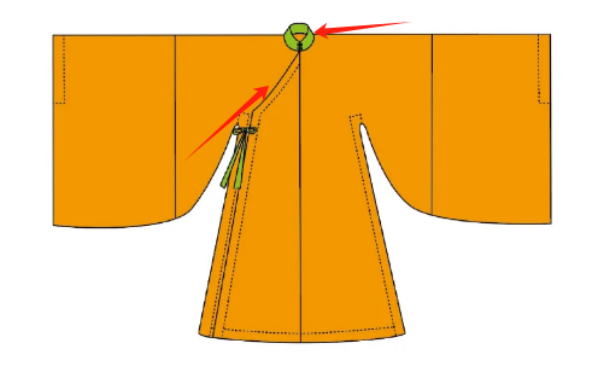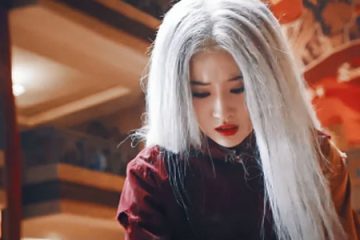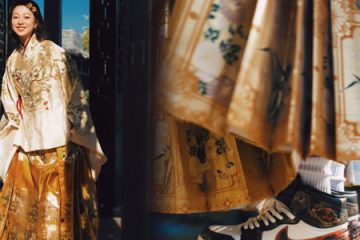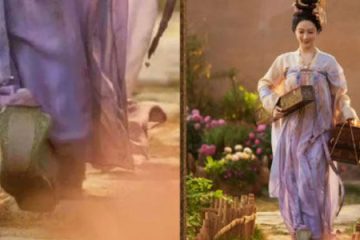Take a Look at Chen Duling’s Off-Shoulder Hanfu Look

Previously, Chen Duling appeared on a show wearing a fashion-forward outfit inspired by Hanfu. The design featured an off-shoulder cut that revealed her shoulders, giving it a stylish, modern flair. However, some netizens questioned whether it’s appropriate to modify Hanfu this way—wondering if it might be too casual or not true to tradition.
Ⅰ. Hanfu-Inspired Design Breakdown
This outfit takes inspiration from the Ming-style standing-collar, diagonal-front long robe. It features gold-trimmed seams and bird embroidery on the upper garment. While it retains traditional elements like the tie closures, the sleeves have been removed and replaced with a sleeveless, raglan-style cut. As a result, the outfit leans more toward contemporary fashion aesthetics. The sleeveless design also makes it practical and comfortable for summer wear.

The “standing collar with diagonal closure” is a commonly used term to describe a style of Hanfu that was popular during the mid-Ming Dynasty. It combines two standard elements in Hanfu terminology: the “standing collar” and the “diagonal closure” (sometimes referred to as a “large front panel”). This naming method—collar type plus closure style—is a typical way to describe Hanfu garment structures.

As for the color scheme, this piece features a rich “palace red,” a flattering tone that enhances the complexion. When paired with white, the red feels less heavy and more refined. The generous use of white space in the outfit prevents it from appearing too formal or overwhelming, instead giving it a graceful and balanced elegance. The contrast between red and white adds visual harmony and charm to the overall look.

The skirt is designed with a modern, fitted silhouette rather than the traditional wrapped structure found in Hanfu. Instead, it features a back zipper for a snug fit and takes on the look of a pencil skirt. While the front retains the appearance of a tied waistband, the actual skirt head has an asymmetrical design. Overall, the piece is inspired by Hanfu elements but leans more toward a contemporary fashion aesthetic. Paired with a simple braided hairstyle, it balances modern styling with a touch of tradition.

The top uses a raglan sleeve cut, making it more breathable and comfortable for summer wear while still keeping traditional Hanfu features like the diagonal front opening and inner/outer tie closures. This blend of fashion-forward design and traditional structure gives the outfit a flowing, elegant look when walking.

Ⅱ. Some Thoughts
Tradition also benefits from thoughtful innovation. As Hanfu culture continues to grow and evolve, it’s only natural that it adapts to modern lifestyles and diverse occasions. We’re seeing more fashion pieces that blend Hanfu elements with contemporary design—making traditional styles more accessible and wearable in daily life. Incorporating these cultural touches into modern fashion helps more people connect with Hanfu, giving it fresh relevance and vitality.

At the same time, it’s important to preserve Hanfu’s ceremonial and cultural value. Whether during Dragon Boat Festival, Mid-Autumn Festival, Qixi, Spring Festival, or significant life events like weddings and coming-of-age ceremonies, Hanfu can still serve as a form of formal attire. It holds not just aesthetic beauty, but also cultural depth and educational significance. Tradition and fashion aren’t in conflict—they can grow together. This balance of innovation and respect for heritage reflects how many people today view Hanfu, and affirms a deeper cultural confidence.

Summary
This modernized Hanfu-inspired outfit echoes the traditional Ming-style look worn by her character Zhuang Hanyan in The Glory. While both are rooted in the Ming Dynasty Clothing, the design approaches are quite different—one leans more traditional, the other more contemporary. Which style do you prefer? Feel free to leave a comment or share your thoughts. See you next time!



0 Comments